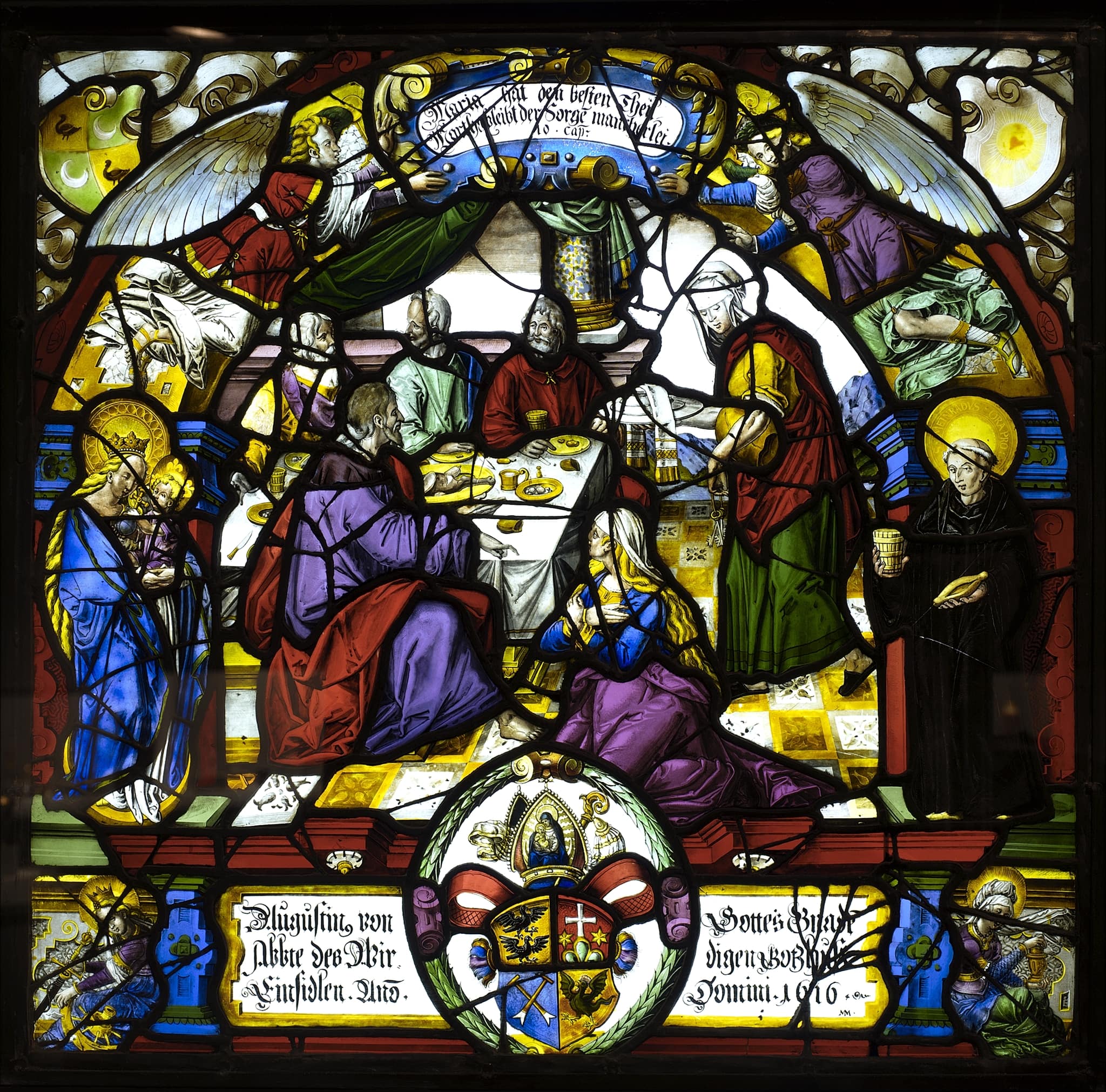The original composition of Rathausen’s cloister, with its sixty-seven panels illuminating its walks, must have created an extraordinary space of prayer and meditation. The story Of Mary and Martha resonates with a special intensity for a monastic community. Christ visits the house of Martha, who “was busy about much serving” while her sister Mary was “sitting also at the Lord's feet, [hearing] his word.” Christ explained that “Mary hath chosen the best part, which shall not be taken away from her” (Luke 10:38-42), the word inscribed on the panel. Thus, a cloistered community is reassured that their primary occupation of prayer is pleasing to Christ. Yet, in Martha’s service, they also see the validity of good works. The very closeness of Mary to Christ brings to mind her conflation with the penitent woman who washed Christ’s feet with her tears (Luke 7:36-50). With this tradition in mind, the Golden Legend states that “Mary made the best choices, namely, the part of penance, the part of inward contemplation and the art of heavily glory” (Ryan, 1993, vol. I, p. 374).
The flanking figures continue an exposition of the values depicted in the narrative. The Virgin is given the honor of place, on the left, (heraldic dexter); she cradles the Christ Child with both arms. Jesus turns towards the Virgin, his imperial orb seemingly a child’s plaything. The Virgin and Child are also depicted in the miter-crest over the Abbot’s arms. On the right, echoing the work of Martha, St. Meinrad stands with supportive gestures of distributing food; drink in his right hand, a loaf of bread in his left, his standard attributes (Herder Lexikon, 1968–76, 7, cols. 625–27). He is revered as the founder of the monastery of Einsiedeln, arguably the most significant religious foundation and pilgrimage site in Switzerland, and thus of great importance in Swiss hagiographic tradition, and certainly to the donor, the abbot of Einsiedeln. Both patron saints emphasize a sense of intimacy and care. St. Meinrad’s position offering hospitality corresponds to Martha’s position as actively engaged in welcoming Christ with food. The loving gaze between the Virgin and her son reflects the gaze of Mary towards Christ. Martha is shown with the symbols of Swiss domestic responsibility, holding the keys to the household in her hand. The status of the wife is shown by the keys that she alone carries attached to her purse. Rather than angels, female saints are depicted on either side of the lower inscription. On the left St. Catherine holds a broken wheel. On the right, Mary Magdalen, with her head swathed in an elaborate cloth, holds an unguent jar.
The panel of Christ in the House of Mary and Martha is signed with the monogram MM (Michael Müller II) after the date. Müller was an important glass painter from Zug (Bergmann, 2004, pp. 90–95). Since 1602, he was recorded as member of the Guild of St. Luke, the organization of painters, and he has left behind a large number of works. Before his commissions for Rathausen, he worked for other monasteries, including Frauenthal, Elgelberg, Wettingen, and probably Einsiedeln. Of similar disposition to the LACMA panel of Mary and Martha is Müller’s signed Rathausen panel of the Arrest of Christ, executed in 1617 (Schweizerisches Nationalmuseum; Schneider, 1970, p. 289, no. 505). There is almost a mannerist elegance in the elongated proportions of the figures. Less animated than Fallenter’s, Müller’s personages move with grave demeanor, their garments flowing in dignified folds. Their faces are oval in form, with elongated foreheads. The noses are long, sometimes undulating and lean faces show considerable modeling of planes and recesses. There is little variation among the colors or values selected for each segment; a face, for example, shows a single beige tonality. A panel showing St. Martin and St. Anne commissioned by the municipality of Baar in 1616 (CV Switzerland, RN4, Bergmann 2004, p. 263, no. 75) is attributed to the Müller workshop and shows the same calm poses and the broad sweep of modulated surfaces as the Los Angeles panel.
The composition of the panel that places Mary at Christ’s feet recalls Fallenter’s scene of The Woman Washing Christ’s Feet (Schweizerisches Nationalmuseum; Schneider, 1970, p. 260, no. 404) that directly preceded it in the cloister. Müller obviously responded to the window installed some twenty years earlier. The placement of Christ is reversed, to the right for Fallenter and to the left for Müller. The two images of Christ thus seem to frame the representations of the women, both on their knees. Repeated again is the perspectival view into the room and the far distant landscape beyond.
Cited in:
Garland sale, 1924, no. 337, illustration showing the window in its original casement.
Hayward, 1989, pp. 72–73.
Raguin, 2024, vol. 1, pp. 24–26, 165–70, 178–80.
